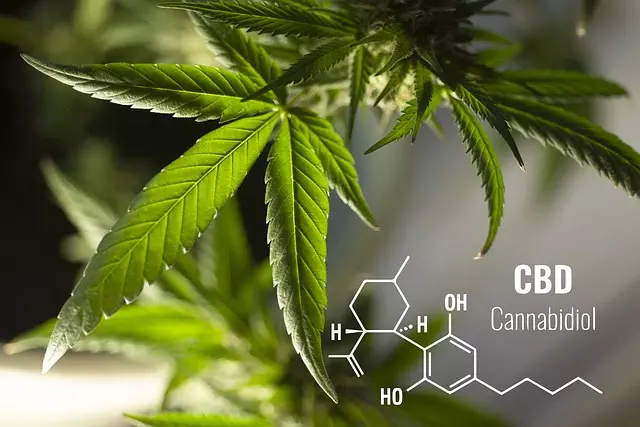High Potency Cannabinoids (HPCs) from cannabis are increasingly under the microscope for their varied effects and therapeutic potential. Beyond CBD and THC, compounds like CBG, CBN, and CBC offer unique benefits. Research is ongoing into their efficacy in managing pain, inflammation, and neurological conditions, with THC showing promise for its analgesic and anti-inflammatory properties, and CBD being clinically substantiated for seizure reduction in epilepsy and anxiety treatment. The legal status of HPCs is complex and varies by jurisdiction, necessitating careful consideration and adherence to regulations such as those set by the FDA. The industry is evolving with the development of patented synthetic cannabinoids, targeted delivery systems, and products with precise dosages and effects, aiming to enhance bioavailability and efficacy. As regulatory frameworks continue to shape the market, HPCs are poised to make significant contributions to mainstream medicine, offering innovative treatments with substantial health benefits. Consumers, manufacturers, and retailers must stay informed about legal developments to ensure safe consumption and responsible marketing practices in this rapidly advancing field.
Discover the intricate world of high potency cannabinoids with our comprehensive article. This exploration delves into their scientific underpinnings, variety within the spectrum, and the complex legal framework governing their use. We will navigate through their medical applications, consumer considerations for safe consumption, and the future trends in research and innovation. Join us as we unravel the potent and transformative nature of high potency cannabinoids.
Understanding High Potency Cannabinoids: A Comprehensive Overview

High potency cannabinoids represent a significant subset of compounds found within the cannabis plant that have garnered attention due to their concentrated effects. Cannabidiol (CBD) and tetrahydrocannabinol (THC) are among the most well-known cannabinoids, with THC being the primary psychoactive component of cannabis and CBD being non-psychoactive but widely recognized for its therapeutic potential. Beyond these, there exists a spectrum of high potency cannabinoids such as Cannabigerol (CBG), Cannabinol (CBN), and Cannabichromene (CBC), each with distinct properties and effects. Research into these compounds has revealed their unique contributions to the cannabis experience, which can vary from medicinal benefits to recreational uses. Understanding the nuances of each cannabinoid’s effect is crucial for consumers and healthcare providers alike, as they navigate the complex cannabinoid landscape for treatment or enhancement of well-being. The scientific community continues to explore the potential applications of high potency cannabinoids, with ongoing studies shedding light on their individual and synergistic effects within the body’s endocannabinoid system. As legal landscapes evolve and research progresses, the knowledge gap surrounding these compounds is narrowing, offering a more comprehensive overview of their roles and benefits in human health and beyond.
The Science Behind Cannabinoid Potency: Factors That Influence Strength

The science behind cannabinoid potency is a complex interplay of various factors that influence the strength of these compounds within the cannabis plant. High potency cannabinoids, such as THC (tetrahydrocannabinol) and CBD (cannabidiol), are not merely a matter of chance but are the result of careful cultivation techniques, genetic selection, and environmental conditions. The biosynthesis of cannabinoids is governed by a delicate network of genes and enzymes; specific gene sequences direct the production of cannabinoid synthesizing enzymes, which in turn convert precursors into the desired cannabinoids.
Environmental factors such as light intensity, temperature, humidity, and nutrient availability can significantly impact the potency and yield of cannabinoids. For instance, optimizing light conditions, particularly the red to blue light ratio, has been shown to enhance the biosynthesis of THC, while other cannabinoids like CBD can be influenced by the timing and duration of light exposure. Similarly, temperature and humidity levels within an ideal range can improve plant health and metabolic efficiency, leading to higher concentrations of cannabinoids. Cultivators often employ a combination of selective breeding and controlled environmental conditions to produce strains with high potency cannabinoids, ensuring that the end product meets specific therapeutic or recreational needs. Understanding these factors allows for the manipulation and optimization of cannabinoid content, which is crucial for both medical and commercial applications in the cannabis industry.
The Spectrum of High Potency Cannabinoids: THC, CBD, and Beyond

High potency cannabinoids, such as THC and CBD, are the focal points of a burgeoning field within phytomedicine. Tetrahydrocannabinol (THC) and Cannabidiol (CBD) are two of the most well-known and researched compounds found in the cannabis plant, each with distinct effects on human physiology and psychology. THC is renowned for its psychoactive properties, influencing mood, perception, and memory, and is often used for its euphoric and pain-relieving effects. In contrast, CBD does not induce a high; rather, it’s celebrated for its potential therapeutic benefits, including anti-inflammatory, anti-anxiety, and anti-seizure properties.
Beyond these widely recognized cannabinoids, the spectrum of high potency compounds includes a multitude of other molecules such as CBN (cannabinol), CBC (cannabichromene), and THCV (tetrahydrocannabivarin), each offering unique attributes. The entourage effect is a phenomenon that highlights the synergistic interaction between these cannabinoids when consumed together, potentially amplifying their therapeutic effects and reducing side effects. This concept underscores the importance of considering the full profile of cannabinoids in any given cannabis product, rather than isolating single compounds. As research continues to evolve, the understanding and utilization of these high potency cannabinoids hold great promise for a wide array of applications in medicine and wellness, making this an area of significant scientific and clinical interest.
Safety and Regulation: Navigating the Legal Landscape of High Potency Cannabinoids

High Potency Cannabinoids (HPCs) are a class of compounds found in cannabis plants that have garnered significant attention due to their potent effects and therapeutic potential. The legal status of HPCs varies widely across different jurisdictions, necessitating a careful navigation of the legal landscape to ensure compliance with local, state, and federal regulations. In the United States, for instance, the 2018 Farm Bill legalized hemp-derived cannabinoids containing less than 0.3% THC on a dry weight basis, but this does not encompass all HPCs. Users must be vigilant about the sources of these compounds to avoid products that may be illegal or unsafe due to their source material or unregulated production methods. Regulatory bodies like the Food and Drug Administration (FDA) play a crucial role in establishing guidelines for the safe use, labeling, and marketing of cannabinoid-based products. It is imperative for consumers, manufacturers, and retailers to stay informed about the evolving legal framework surrounding HPCs to prevent health risks and ensure that these products are marketed responsibly. As such, the legal clarity and regulatory oversight are essential components in the safe utilization of High Potency Cannabinoids.
Medical Applications: Exploring the Therapeutic Potential of High Potency Cannabinoids

High potency cannabinoids have garnered significant attention within the medical community due to their potential therapeutic benefits. These compounds, found in the Cannabis sativa plant, include a variety of cannabinoids such as THC (tetrahydrocannabinol) and CBD (cannabidiol), with THC being particularly known for its psychoactive effects and CBD for its therapeutic properties. Research has indicated that high potency cannabinoids may offer relief for a range of conditions, including chronic pain, inflammation, and certain neurological disorders. For instance, THC has been studied for its analgesic and anti-inflammatory properties, which could be beneficial for patients suffering from conditions like multiple sclerosis and arthritis. Similarly, CBD has shown promise in treating epilepsy and anxiety disorders, with clinical trials demonstrating its efficacy in reducing seizure frequency in patients with epilepsy. The precise mechanisms by which cannabinoids exert their effects are still under investigation, but they are believed to interact with the body’s endocannabinoid system, a complex cell-signaling system that plays a role in regulating a range of functions and maintains internal balance or homeostasis. As research continues, the therapeutic applications of high potency cannabinoids are likely to expand, offering new hope for patients seeking alternative treatments for various medical conditions. The future holds potential for these compounds to be tailored into more precise and effective therapies, with ongoing clinical trials paving the way for a deeper understanding of their medicinal properties.
Consumer Considerations: Dosing and Methods for Optimal Effects

When exploring high potency cannabinoids for personal use or therapeutic purposes, consumer considerations regarding dosing and administration methods are paramount for achieving optimal effects while minimizing risks. The variability in individual body chemistry necessitates a tailored approach to dosing; what is effective for one person may not be for another. It’s essential to start with a low dose and gradually increase it as needed, while closely monitoring effects and adjusting accordingly. This cautious method allows users to find their personal threshold without overstepping into territories that could lead to adverse reactions.
Moreover, the choice of administration method—whether through inhalation, ingestion, sublingual application, or topical application—can significantly influence the onset and duration of effects. Inhalation methods, such as vaporizers or cannabis flowers, offer a rapid onset due to direct delivery into the bloodstream via the lungs. Ingestible products, like edibles or capsules, take longer to kick in but provide prolonged effects, making them suitable for extended relief. Sublingual administrations, such as tinctures, offer a middle ground with quicker absorption than ingestible products but not as immediate as inhalation. Topical applications are ideal for localized relief and have minimal systemic effects, making them a safe option for those sensitive to cannabinoids or those seeking targeted relief from specific conditions. Consumers should consider these methods, their potency levels, and their desired outcomes when selecting the most appropriate product for their needs.
The Future of High Potency Cannabinoids: Research, Development, and Innovation in the Field

High potency cannabinoids (HPCs) represent a burgeoning field within cannabis research and development, where scientists and manufacturers are honing in on specific compounds for their therapeutic potential. As of now, the scientific community is actively engaged in unraveling the intricate mechanisms by which these cannabinoids interact with the human endocannabinoid system, aiming to elucidate their effects on various health conditions. The future of HPCs is poised at the intersection of pharmacological innovation and clinical application, with ongoing studies exploring their efficacy in treating a range of disorders, from chronic pain and inflammation to anxiety and neurological diseases.
Innovation in the field of high potency cannabinoids is driven by advancements in extraction techniques, purification processes, and formulation methodologies. These technological strides enable researchers to isolate and manipulate cannabinoids with greater precision, leading to the development of new products with specific dosages and effects. The industry is also witnessing a rise in patented synthetic forms of HPCs, as well as novel delivery systems designed to improve bioavailability and onset of action. As regulatory frameworks evolve, there is an increasing opportunity for these high-potency compounds to be integrated into mainstream medicine, offering patients and healthcare providers new therapeutic options with potentially significant health benefits.



